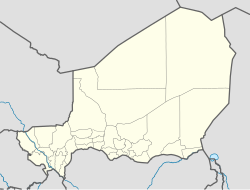Garhanga
| Garhanga | |
|---|---|
| Commune and village | |
| Location in Niger | |
| Coordinates: 14°33′N 5°46′E / 14.550°N 5.767°E | |
| Country |
|
| Region | Tahoua |
| Department | Keita Department |
| Population (2012) | |
| • Total | 69,712 |
| Time zone | WAT (UTC+1) |
Garhanga is a village and rural commune in Niger. It is located in the Keita Department of the Tahoua region. As of 2012, it has a population of 69,712.
Garhanga lies in the Sahel biome. The neighboring municipalities are Keita in the north, Ibrohamane in the northeast, Tabotaki in the east, Deoule in the southeast, Allakaye in the south, Badaguichiri in the southwest and Tamaske in the west. The municipality is divided into 40 administrative villages, two traditional villages and 22 hamlets. The main town of the rural community is the administrative village of Garhanga.
The varied landforms in the commune consist of plateaus, valleys and their catchments. The average annual rainfall in the municipality was 458.84 millimeters in the period between 1997 and 2006 with an average of 41 rainy days in the year. The rainy season typically lasts from June to September. The once rich wildlife Garhangas has increasingly declined since the 1950s. In the plateaus occasionally grow acacia, Ziziphus mauritiana, Piliostigma reticulatum and Balanites aegyptiaca. In the valleys there is dense vegetation. The wild animal population - monkeys, squirrels, rabbits, and guinea fowl - is hurt by a lack of habitat, water shortages and increasing human settlement in the area.
Birni Ader (also: Birni n'Ader), today an administrative village in the municipality of Garhanga, was in 1674 named the capital of the province of Ader in the Sultanate of Agadez. In the early 19th century, the capital was moved to Illela. The French first created in 1904 the cantons of Keita, Tahoua and Illela. In 1913, the canton of Keita was subdivided into Keita, Tamaské, and Garhanga.
...
Wikipedia

